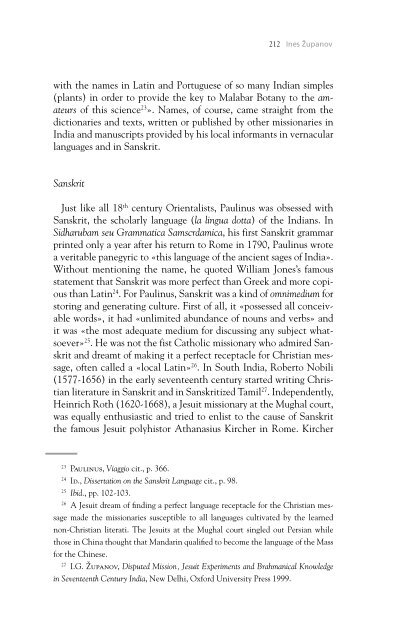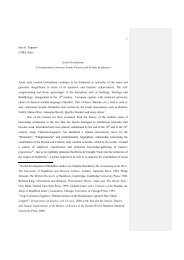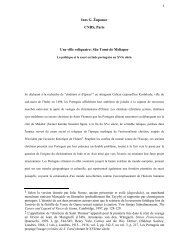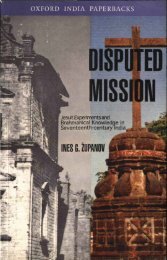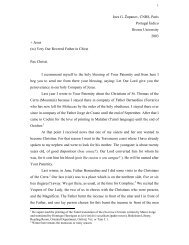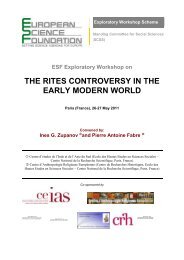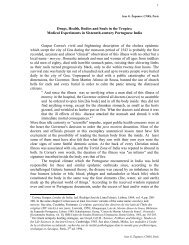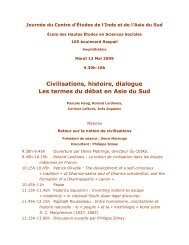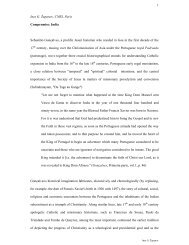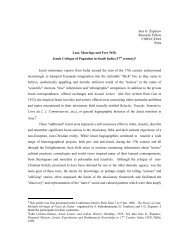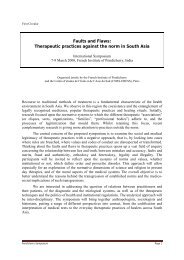Professional Missionary and Orientalist Curator ... - Ines G. Županov
Professional Missionary and Orientalist Curator ... - Ines G. Županov
Professional Missionary and Orientalist Curator ... - Ines G. Županov
Create successful ePaper yourself
Turn your PDF publications into a flip-book with our unique Google optimized e-Paper software.
212 <strong>Ines</strong> <strong>Županov</strong><br />
with the names in Latin <strong>and</strong> Portuguese of so many Indian simples<br />
(plants) in order to provide the key to Malabar Botany to the amateurs<br />
of this science 23 ». Names, of course, came straight from the<br />
dictionaries <strong>and</strong> texts, written or published by other missionaries in<br />
India <strong>and</strong> manuscripts provided by his local informants in vernacular<br />
languages <strong>and</strong> in Sanskrit.<br />
Sanskrit<br />
Just like all 18 th century <strong>Orientalist</strong>s, Paulinus was obsessed with<br />
Sanskrit, the scholarly language (la lingua dotta) of the Indians. In<br />
Sidharubam seu Grammatica Samscrdamica, his first Sanskrit grammar<br />
printed only a year after his return to Rome in 1790, Paulinus wrote<br />
a veritable panegyric to «this language of the ancient sages of India».<br />
Without mentioning the name, he quoted William Jones’s famous<br />
statement that Sanskrit was more perfect than Greek <strong>and</strong> more copious<br />
than Latin 24 . For Paulinus, Sanskrit was a kind of omnimedium for<br />
storing <strong>and</strong> generating culture. First of all, it «possessed all conceivable<br />
words», it had «unlimited abundance of nouns <strong>and</strong> verbs» <strong>and</strong><br />
it was «the most adequate medium for discussing any subject whatsoever»<br />
25 . He was not the fist Catholic missionary who admired Sanskrit<br />
<strong>and</strong> dreamt of making it a perfect receptacle for Christian message,<br />
often called a «local Latin» 26 . In South India, Roberto Nobili<br />
(1577-1656) in the early seventeenth century started writing Christian<br />
literature in Sanskrit <strong>and</strong> in Sanskritized Tamil 27 . Independently,<br />
Heinrich Roth (1620-1668), a Jesuit missionary at the Mughal court,<br />
was equally enthusiastic <strong>and</strong> tried to enlist to the cause of Sanskrit<br />
the famous Jesuit polyhistor Athanasius Kircher in Rome. Kircher<br />
23<br />
Paulinus, Viaggio cit., p. 366.<br />
24<br />
Id., Dissertation on the Sanskrit Language cit., p. 98.<br />
25<br />
Ibid., pp. 102-103.<br />
26<br />
A Jesuit dream of finding a perfect language receptacle for the Christian message<br />
made the missionaries susceptible to all languages cultivated by the learned<br />
non-Christian literati. The Jesuits at the Mughal court singled out Persian while<br />
those in China thought that M<strong>and</strong>arin qualified to become the language of the Mass<br />
for the Chinese.<br />
27<br />
I.G. <strong>Županov</strong>, Disputed Mission, Jesuit Experiments <strong>and</strong> Brahmanical Knowledge<br />
in Seventeenth Century India, New Delhi, Oxford University Press 1999.


